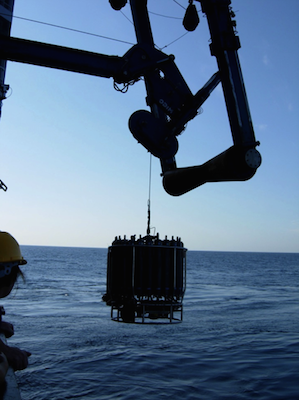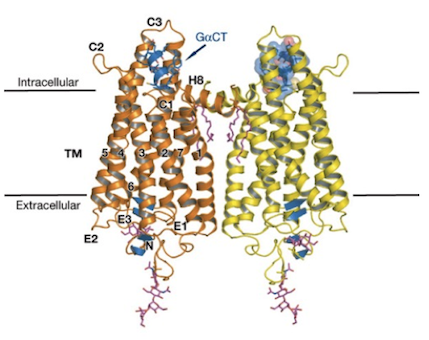Research highlights from our 2014 REF submission
Academics within the School of Biological and Chemical Sciences are involved in a wide range of ground breaking projects across the broad sweep of biological, chemical and psychological sciences. The Research Excellence Framework (REF) 2014 will consider the strength of our research in six core areas.
Aquatic Ecology
We have arguably the strongest Aquatic Ecology research group in the UK. Major research achievements, from this group, have centred on the formulation of climate change frameworks, the effects of global warming on aquatic organisms and ecosystems, and the discovery of potential new pathways in the cycling of the key bio-element, nitrogen.

Research highlight
Vast expanses (30 million km2) of the ocean contain very little oxygen, yet, rather than being dead, they help sustain life on Earth. Nitrogen, second only to carbon in life, is cycled through these ‘oxygen minimum zones’ back to the atmosphere. To date the focus has been on inorganic, simpler forms of nitrogen, yet our research suggests that more complex, organic forms are returned directly to the atmosphere, thus altering our perception of how this vital element is cycled on Earth.
Photograph shows scientists from Queen Mary University of London working in the tropical North Pacific - the largest oxygen minimum zone on Earth.
- Read the paper in full: “Evidence for the direct oxidation of organic nitrogen to N2 gas in the Arabian Sea”
Biological Psychology
Our Biological Psychology department arose from an initiative to develop our School’s strengths in animal behaviour and cognition. This group works on innovative research at the interface between psychology and biology. A wide range of models are studied including bees, corvids & primates, zebra finches, zebra fish, goats, cattle and deer and humans.

Research highlight
Scientists from Queen Mary University of London used genome-sequencing methods to advance the study of vocal communication in songbirds like the zebra finch. In these animals, vocal interactions trigger complex changes in gene expression in the brain, which can illuminate the biology underlying the evolution and learning of human language.
- Read the paper in full: “The genome of a songbird”
Evolution and Genetics
Our Evolution and Genetics group has one of the highest concentrations of evolutionary genomics researchers in the UK. Recent projects have investigated genome restructuring following polyploidy in plants, social organisation in fire ants, and food web tracking (in both tropical and temperate systems) to investigate ecosystem functioning and evolution. Watch Dr Clare discuss her work on bats and food webs in the video below:
- You can also watch Dr Clare’s research video on YouTube
Research highlight
Research ascertained that genome restructuring following polyploidy in plants is astonishingly fast. Professor Leitch explains:
“In plants unexpected, fertile hybrid combination occurs; sometimes between distantly related species. The hybridization processes is often associated with the doubling of chromosome numbers, a process called polyploidy. Together, these processes of hybridization and polyploidy have driven the evolution of plants. Scientists at Queen Mary have shown that polyploidy leads to astonishing fast genome evolution and altered activities of genes. That directly impacts ecosystem functioning and the foods that we eat; indeed without polyploidy underpinning our crops we could neither feed nor clothe all the people on earth.”
- Read the paper in full: “Genomic Plasticity and the Diversity of Polyploid Plants”
Physical and Theoretical Chemistry
Physical and Theoretical Chemistry is a new branch of our Chemistry department and builds upon existing areas of research strength. The main areas of research interest include hetero/homogeneous and organo-catalysis, colloids, biological building blocks, radical chemistry and electron-transfer, amorphous materials.

Research highlight
Within this group, Professor Vlcek’s research elucidates the character and dynamics of photo-induced ultrafast physical and chemical processes. Understanding the relationship between structure and function of the excited state underpins applications in photonics, molecular electronics and energy conversion.
Figure shows photo-triggered ultrafast electron flow and rectification in ReI-labelled Azurin. Ultra-fast electron transfer occurs from a CuI centre 2 nm away in less than 50ns when a tryptophan is introduced (W122). Hopping through the intervening tryptophan splits the path in two and increases electronic coupling.
- Read the paper in full: “Tryptophan-accelerated electron flow through proteins”
Structural Biology and Photosynthesis
Our work on structural biology was highlighted as excellent in the 2008 Research Assessment Exercise. We continue to invest in these projects and have complemented this work with the further development of a distinctive cluster of excellence in photosynthesis research. Major achievements are determination of the structures of membrane proteins, biosynthetic enzymes, protein complexes and supra-molecular complexes.
Research highlights
Substantial advances in understanding how membrane proteins work have been made by the structural biology and photosynthesis groups. The structure of the first G-protein coupled receptor (opsin) in complex with its cognate G-protein was a major step forward in understanding this important family of enzymes which are drug targets as well as photo-transducers.
- Read the paper in full: “Crystal structure of opsin in its G-protein-interacting conformation”
Professor Pickersgill’s determination of the structure of cobalamin biosynthetic enzymes has elucidated mechanism in these enzymes and revealed the interactions responsible for trapping products. Product trapping prevents off-pathway interactions and protects labile intermediates possibly also conferring additional specificity to the biosynthetic cascade. Determination of the structures of protein complexes from the type II bacterial secretion system has revealed interactions essential for forming a functional secretion system.
- Read the paper in full: “Structural and functional insights into the pilotin-secretin complex of the type II secretion system”
Synthesis and Catalysis
We are home to a successful research programme in Synthesis and Catalysis with a central theme of developing new, innovative synthetic and catalytic methods, and applying them in a wide range of areas. The main areas of research interest include small molecule sensors, biomolecular nanoarrays, synthetic methodology development, and molecularly imprinted nanogels and drug delivery systems.

Research highlight
The Resmini group has focused on the development of imprinted microgels and nanogels with enzyme-like activities in the aldol condensation and carbonate hydrolysis; as well as for reactions where no enzyme exists, like the Kemp elimination.
The imprinted polymers have also been obtained with protein-like sizes and successfully used as synthetic antibodies and as the recognition element of a fiber optic sensor. These versatile materials are currently being evaluated as drug delivery systems for the skin, where the molecular imprinting approach is a very powerful tool that allows very good uploading efficiency and elevated drug incorporation.